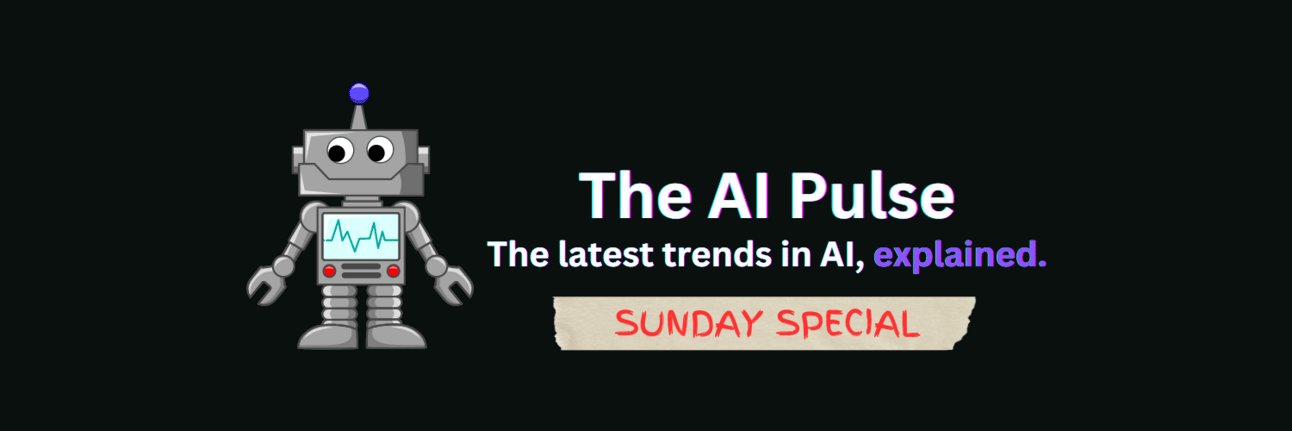
Welcome back AI prodigies!
In today’s Sunday Special:
🕹Click, Wait, Done
🧬Human-AI Detachment
🔑Key Takeaway
Read Time: 6 minutes
🎓Key Terms
Human-Computer Interaction: a specialized field of computer science focusing on user interfaces, modalities (e.g., text or speech), and open-ended dialogues between humans and computational systems.
Large Action Models (LAMs): software agents that perform tasks to help us accomplish goals without human intervention (e.g., schedule an appointment).
Hallucinations: when a chatbot presents false information as fact, often in a confident or matter-of-fact tone.
🕹ACTIVE INTERACTION IS A GAME CHANGER
Human-computer interaction is evolving from passive to active. When we use computers, clicking and typing require us to perform actions to reach our goals. To search for information online, you type a relevant keyword, phrase, or question, and the software aggregates the most relevant websites. Although search engines occasionally retrieve and present information directly (e.g., Google Search’s featured snippets), such features tend to falter when faced with more complex queries. And even if the information presented answers your question, it’s typically a means to an end, not an end. When you book a hotel reservation, you search for a hotel based on your personal preferences. Then, you must still navigate to the booking page, coordinate with your schedule, and either log in or input a ton of information you wish to be auto-filled. And in some cases, you might have to call. Searching for “cheap boutique hotels in London” doesn’t accomplish a goal; it’s simply the first of many steps to booking accommodation.
The rise of active interactions, or software agents performing most actions to meet a goal, will gradually eliminate everyday hassles, freeing time for more cognitively or emotionally immersive activities. Technologies behind this shift include Large Action Models (LAMs) or software agents that perform tasks autonomously. Check out this new LAM, Rabbit OS, as it learns how to book an AirBnB. To train LAMs to perform simple, recurring tasks (e.g., booking your haircut), you have to perform them once manually. For less frequent, more expensive purchases like a used car, humans will be an integral part of the process for the foreseeable future. However, LAMs will perform the most tedious aspects and provide recommendations:
You state your preferences: budget, mileage, make, model, year, and features.
LAM aggregates a dozen vehicles from hundreds of websites.
You fine-tune its filters.
LAM presents the seller’s contact information for the five best vehicles and drafts an initial message to send an inquiry via email or text.
You call the seller, negotiate, complete the paperwork, and seal the deal.
🧬HUMAN-AI DETACHMENT
LAMs promise revolutionary time-savings, but at what cost? Agent error and, subsequently, liability are top concerns. Large Language Models (LLMs), which are far more developed and widely deployed than LAMs, are filled with hallucinations; one independent assessment found that about 55% of open-source chatbot answers to context-aware questions contain hallucinations. LAMs present an even greater hallucination risk because their mistakes compound, as a misinterpretation of human direction on the first step derails the entire process. What happens when the LAM accidentally buys the car without human approval? Juries will adjudicate questions of liability in the coming years.
However, the shift from passive to active human-computer interaction raises more fundamental questions that shouldn’t be settled in court. How will humans accept, adopt, and adapt to engaging with these social agents? Additionally, how much agency will we give them? Might they coordinate to accomplish goals for more than one person? We’ll have to address these questions well before we sort out issues arising from doomsday superhuman AI, or Artificial General Intelligence (AGI), which likely lie decades away. Users should not underestimate the sociocultural implications of revolutionary technology. Social technologies have made us less social. AI technologies might make us less robotic.
The disconnect between what technology aims to achieve and what it achieves results from its messy commingling with the human psyche. And thanks to the slow rate of evolution, longstanding human nature manifests in modern environments:
Negativity Bias: We used to face countless physical threats, detecting them to stay safe. Although negative news rarely poses an immediate threat, we categorize it as unfavorable in 120 milliseconds (i.e., as fast as we blink when unaware), evoking fear, anxiety, or sadness.
Fear of Missing Out (FOMO): Social isolation from the tribe used to spell certain death. Now, watching either friends or strangers have fun makes us depressed, and marketers leverage the fact that 72% of Facebook users feel left out to drive conversions.
Dopamine Release: The most well-known neurotransmitter motivates us to act in ways we think will please us. However, when pleasure-seeking activities are effortless, the actual reward falls short of the expected reward, leading to regret; one study found that users regretted smartphone use in 40% of sessions.
🔑KEY TAKEAWAY
Just like social technologies amplify the variability and reach of an individual user’s emotions, LAMs will amplify the impact of our actions downstream of our nature. Creators will delegate repetitive, drudgerous tasks to unlock more creativity. Criminals may delegate to increase efficiency or escape culpability. However, on the net, autonomous agents will likely help us save our most precious resource—time. How we spend it is up to us.
📒FINAL NOTE
If you found this useful, follow us on Twitter or provide honest feedback below. It helps us improve our content.
How was today’s newsletter?
❤️AI Pulse Review of The Week
“This is seriously awesome content.”
🎁NOTION TEMPLATES
🚨Subscribe to our newsletter for free and receive these powerful Notion templates:
⚙️150 ChatGPT prompts for Copywriting
⚙️325 ChatGPT prompts for Email Marketing
📆Simple Project Management Board
⏱Time Tracker
